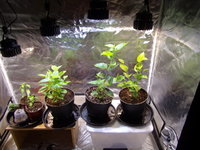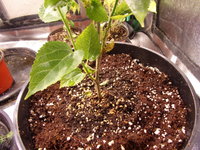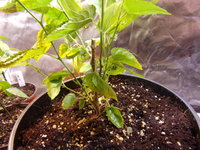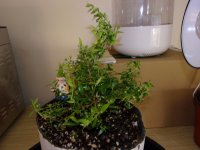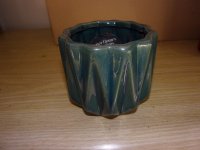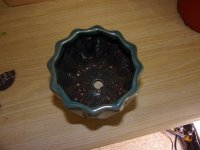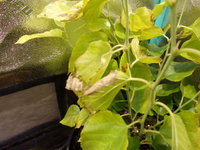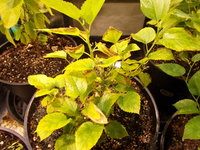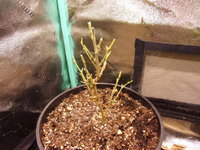You are using an out of date browser. It may not display this or other websites correctly.
You should upgrade or use an alternative browser.
You should upgrade or use an alternative browser.
Indoor Mulberry Mini Rose and Common Myrtle
- Thread starter LiquidSkin
- Start date
LiquidSkin
Yamadori
Here's an update on the Dwarf Everbearing Mulberry cuttings I received from Lake Worth Florida where it rarely goes below 60F. After a 6ish weeks of rooting in little 3" pots they were ready for transplant into 6" pots. Organic slow release fertilizer applied after transplant.
This one is doing best of the lot

Group shot of the other 3

I cut the fruit off whenever it forms to put energy into growing rather than producing a few fruit.
This one is doing best of the lot

Group shot of the other 3

I cut the fruit off whenever it forms to put energy into growing rather than producing a few fruit.
LiquidSkin
Yamadori
Leo in N E Illinois
The Professor
- Messages
- 11,613
- Reaction score
- 24,272
- USDA Zone
- 5b
@LiquidSkin - your horticulture skills have improved nicely. The most recent photo of mulberries are much healthier looking than your initial photos. Nice. For the moment, or the winter, I would work on letting these get bigger and bushier.
Then late winter or spring you can do a cut back. A couple more cycles of grow out and cut back, and then it will be time to look for a trunk line to make these little "shrubs" look more tree like, if you want to go the bonsai route. If you just want them as indoor fruit trees, keeping them shrub style will give you more fruit yield.
At some point, Not now, but maybe a year or two from now. If you go "bonsai", they will need bonsai pots, as the bonsai pot serves as the base, analogous to a picture frame, to set the image of a "tree". Bonsai is not a literal miniature tree. Bonsai is an abstract representation of a tree, with the focus being to elicit the an emotional response from the viewer as if they are seeing a scene from nature. The response does not need to be raw emotion, it can be quite subtle. But the purpose of the pot is to set the "place", be it a meadow, mountain, field, or forest or just to lift out of the ordinary realm of the windowsill or bench the tree is being displayed on. So bonsai pots serve a purpose. They are matched to the style of the tree. So first comes shaping the tree, giving it a style. Then, later choosing the pot to compliment the style of the tree.
I saw one of the miniature roses in the photo, glad they are growing. In your reading look up the bonsai related term "Kusamono". This is a category or sub-category of bonsai where roses fit in very nicely. The English translation of Kusamono is often loosely translated as "accent plant", but this does not cover the full range of what Kusamono can be used for. There are many sub-categories of Kusamono. First is "Shita kusa" which is the literal accent plant. Shita-kusa is always displayed with a tree. The height of the Shita-kusa is always shorter than the top of the stand that the tree is displayed on. The shita-kusa is chosen to one or more of the following; time of year, location, or evoke a particular emotion. Most often for location shita-kusa will signal a meadow or a forest, by being an understory species. A miniature rose could indicate an open meadow or cottage setting, where there is sunlight, and it could indicate early summer in flower. In fruit with leaves in autumn color, it could indicate autumn.
The general term "Kusamono" literally means "grassy thing" more or less. In early bonsai traditions Kusamono were always a mixed planting of 3 or more species and at least one of the species was a grass and one blooming herb. Modern bonsai has pretty much discarded the "rules" to just vague suggestions. Larger plantings if paired with trees are often visually separated from the trees, either into foreground or background to create depth and or distance. Or they are displayed on their own.
There is also the category of Kusamono where the accent plant is the focal point of the display. This is called "Sanyasou". Here the planting, in your case the rose would be the focal point. For this category the focal point must be very well grown and have significant evidence of age and maturity. It has to have a "presence". Your roses are a decade away from this point. But they could get there.
There is an artist, Young Choe, who has a great website showing different styles of Kusamono.
 www.kusamonochoe.com
www.kusamonochoe.com
Then late winter or spring you can do a cut back. A couple more cycles of grow out and cut back, and then it will be time to look for a trunk line to make these little "shrubs" look more tree like, if you want to go the bonsai route. If you just want them as indoor fruit trees, keeping them shrub style will give you more fruit yield.
At some point, Not now, but maybe a year or two from now. If you go "bonsai", they will need bonsai pots, as the bonsai pot serves as the base, analogous to a picture frame, to set the image of a "tree". Bonsai is not a literal miniature tree. Bonsai is an abstract representation of a tree, with the focus being to elicit the an emotional response from the viewer as if they are seeing a scene from nature. The response does not need to be raw emotion, it can be quite subtle. But the purpose of the pot is to set the "place", be it a meadow, mountain, field, or forest or just to lift out of the ordinary realm of the windowsill or bench the tree is being displayed on. So bonsai pots serve a purpose. They are matched to the style of the tree. So first comes shaping the tree, giving it a style. Then, later choosing the pot to compliment the style of the tree.
I saw one of the miniature roses in the photo, glad they are growing. In your reading look up the bonsai related term "Kusamono". This is a category or sub-category of bonsai where roses fit in very nicely. The English translation of Kusamono is often loosely translated as "accent plant", but this does not cover the full range of what Kusamono can be used for. There are many sub-categories of Kusamono. First is "Shita kusa" which is the literal accent plant. Shita-kusa is always displayed with a tree. The height of the Shita-kusa is always shorter than the top of the stand that the tree is displayed on. The shita-kusa is chosen to one or more of the following; time of year, location, or evoke a particular emotion. Most often for location shita-kusa will signal a meadow or a forest, by being an understory species. A miniature rose could indicate an open meadow or cottage setting, where there is sunlight, and it could indicate early summer in flower. In fruit with leaves in autumn color, it could indicate autumn.
The general term "Kusamono" literally means "grassy thing" more or less. In early bonsai traditions Kusamono were always a mixed planting of 3 or more species and at least one of the species was a grass and one blooming herb. Modern bonsai has pretty much discarded the "rules" to just vague suggestions. Larger plantings if paired with trees are often visually separated from the trees, either into foreground or background to create depth and or distance. Or they are displayed on their own.
There is also the category of Kusamono where the accent plant is the focal point of the display. This is called "Sanyasou". Here the planting, in your case the rose would be the focal point. For this category the focal point must be very well grown and have significant evidence of age and maturity. It has to have a "presence". Your roses are a decade away from this point. But they could get there.
There is an artist, Young Choe, who has a great website showing different styles of Kusamono.
Kusamono
LiquidSkin
Yamadori
Big bushy and healthy is the goal. Thank you for the compliment!@LiquidSkin - your horticulture skills have improved nicely. The most recent photo of mulberries are much healthier looking than your initial photos. Nice. For the moment, or the winter, I would work on letting these get bigger and bushier.
I think 2 or 3 will become bonsai and 1 will be for fruit. I have terrible vision in my right eye and mulberries are supposed to be good for your eyes.Then late winter or spring you can do a cut back. A couple more cycles of grow out and cut back, and then it will be time to look for a trunk line to make these little "shrubs" look more tree like, if you want to go the bonsai route. If you just want them as indoor fruit trees, keeping them shrub style will give you more fruit yield.
Can you recommend a good place to buy bonsai pots online? There are not many bonsai nuseries in Maine. At least not within close distance.At some point, Not now, but maybe a year or two from now. If you go "bonsai", they will need bonsai pots, as the bonsai pot serves as the base, analogous to a picture frame, to set the image of a "tree". Bonsai is not a literal miniature tree. Bonsai is an abstract representation of a tree, with the focus being to elicit the an emotional response from the viewer as if they are seeing a scene from nature. The response does not need to be raw emotion, it can be quite subtle. But the purpose of the pot is to set the "place", be it a meadow, mountain, field, or forest or just to lift out of the ordinary realm of the windowsill or bench the tree is being displayed on. So bonsai pots serve a purpose. They are matched to the style of the tree. So first comes shaping the tree, giving it a style. Then, later choosing the pot to compliment the style of the tree.
Unfortunately one of the roses died after I cut it back too hard. I'll research more about kusamono and accent plants.I saw one of the miniature roses in the photo, glad they are growing. In your reading look up the bonsai related term "Kusamono". This is a category or sub-category of bonsai where roses fit in very nicely. The English translation of Kusamono is often loosely translated as "accent plant", but this does not cover the full range of what Kusamono can be used for. There are many sub-categories of Kusamono. First is "Shita kusa" which is the literal accent plant. Shita-kusa is always displayed with a tree. The height of the Shita-kusa is always shorter than the top of the stand that the tree is displayed on. The shita-kusa is chosen to one or more of the following; time of year, location, or evoke a particular emotion. Most often for location shita-kusa will signal a meadow or a forest, by being an understory species. A miniature rose could indicate an open meadow or cottage setting, where there is sunlight, and it could indicate early summer in flower. In fruit with leaves in autumn color, it could indicate autumn.
Thank you greatly for all the info.The general term "Kusamono" literally means "grassy thing" more or less. In early bonsai traditions Kusamono were always a mixed planting of 3 or more species and at least one of the species was a grass and one blooming herb. Modern bonsai has pretty much discarded the "rules" to just vague suggestions. Larger plantings if paired with trees are often visually separated from the trees, either into foreground or background to create depth and or distance. Or they are displayed on their own.
There is also the category of Kusamono where the accent plant is the focal point of the display. This is called "Sanyasou". Here the planting, in your case the rose would be the focal point. For this category the focal point must be very well grown and have significant evidence of age and maturity. It has to have a "presence". Your roses are a decade away from this point. But they could get there.
There is an artist, Young Choe, who has a great website showing different styles of Kusamono.
Kusamono
www.kusamonochoe.com
LiquidSkin
Yamadori
I really like the double stemmed one as a "father son" type twin trunk bonsai eventually
Leo in N E Illinois
The Professor
- Messages
- 11,613
- Reaction score
- 24,272
- USDA Zone
- 5b
Finding pots:
You can start in the "Other Selling" subforum down the list here on Bonsai Nut. There are a dozen potters here on BNut who make and sell pots.
I also shop potters who are not members

Matt Owinga https://kaedebonsai-en.com Matt imports higher end Japanese pots if you want a traditional pot.
@sorce - our member Sorce sells pots.
And too many others to list
You can start in the "Other Selling" subforum down the list here on Bonsai Nut. There are a dozen potters here on BNut who make and sell pots.
I also shop potters who are not members

SARA RAYNER POTTERY - Sara Rayner Pottery
SARA RAYNER BONSAI POTTERY WEB SITE UNDER DEVELOPMENT No Orders Can Be Made. Please Check Back Soon. ABOUT Sara Rayner Pottery is located in the small river town of Red Wing, Minnesota just south-east of Minneapolis-St.Paul on the Mississippi river. I have been a potter since 1977, but have...
sararaynerpottery.com
Matt Owinga https://kaedebonsai-en.com Matt imports higher end Japanese pots if you want a traditional pot.
@sorce - our member Sorce sells pots.
And too many others to list
Last edited:
Leo in N E Illinois
The Professor
- Messages
- 11,613
- Reaction score
- 24,272
- USDA Zone
- 5b
Google bonsai pottery, also tokonome pottery
LiquidSkin
Yamadori
LiquidSkin
Yamadori
LiquidSkin
Yamadori
Leo in N E Illinois
The Professor
- Messages
- 11,613
- Reaction score
- 24,272
- USDA Zone
- 5b
Your myrtle is blooming, a sign of its being happy. Nice
LiquidSkin
Yamadori
LiquidSkin
Yamadori
LiquidSkin
Yamadori
Leo in N E Illinois
The Professor
- Messages
- 11,613
- Reaction score
- 24,272
- USDA Zone
- 5b
A touch too dry between watering? That would be my guess. Leaves on mulberry will not " live forever", these might just be aging out. If only older leaves, one year or more old get the browning, don't worry about it. Do check close for pests, just in case.
My best guess(es) are a touch too dry or leaves aging out, essentially autumnal leaf drop even though you are keeping them indoors. Trees don't forget their origins.
My best guess(es) are a touch too dry or leaves aging out, essentially autumnal leaf drop even though you are keeping them indoors. Trees don't forget their origins.
LiquidSkin
Yamadori
It most likely isn't pests because I treated all of them with a systemic insecticide. Could be too dry though I'm still learning how often they need watering.A touch too dry between watering? That would be my guess. Leaves on mulberry will not " live forever", these might just be aging out. If only older leaves, one year or more old get the browning, don't worry about it. Do check close for pests, just in case.
My best guess(es) are a touch too dry or leaves aging out, essentially autumnal leaf drop even though you are keeping them indoors. Trees don't forget their origins.
LiquidSkin
Yamadori
LiquidSkin
Yamadori
LiquidSkin
Yamadori
Here is the bane of my existence an indoor chinese elm. Over the years I've had 2 or 3 of these die probably because they ship in a mixture of coarse bonsai soil and some kind of organic coir.
This time I wont transplant until it is growing and happy. Hopefully it isn't infested with spider mites or similar.
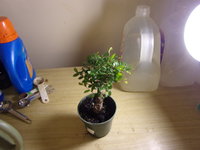

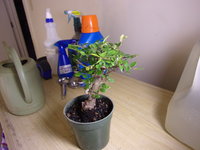
This time I wont transplant until it is growing and happy. Hopefully it isn't infested with spider mites or similar.



Similar threads
- Replies
- 65
- Views
- 10K
- Replies
- 45
- Views
- 1K




